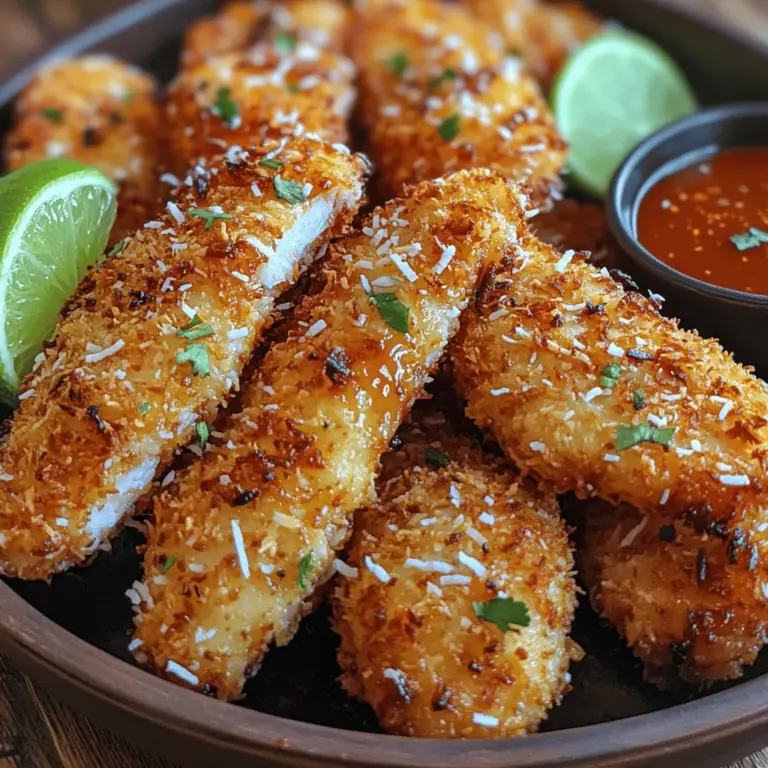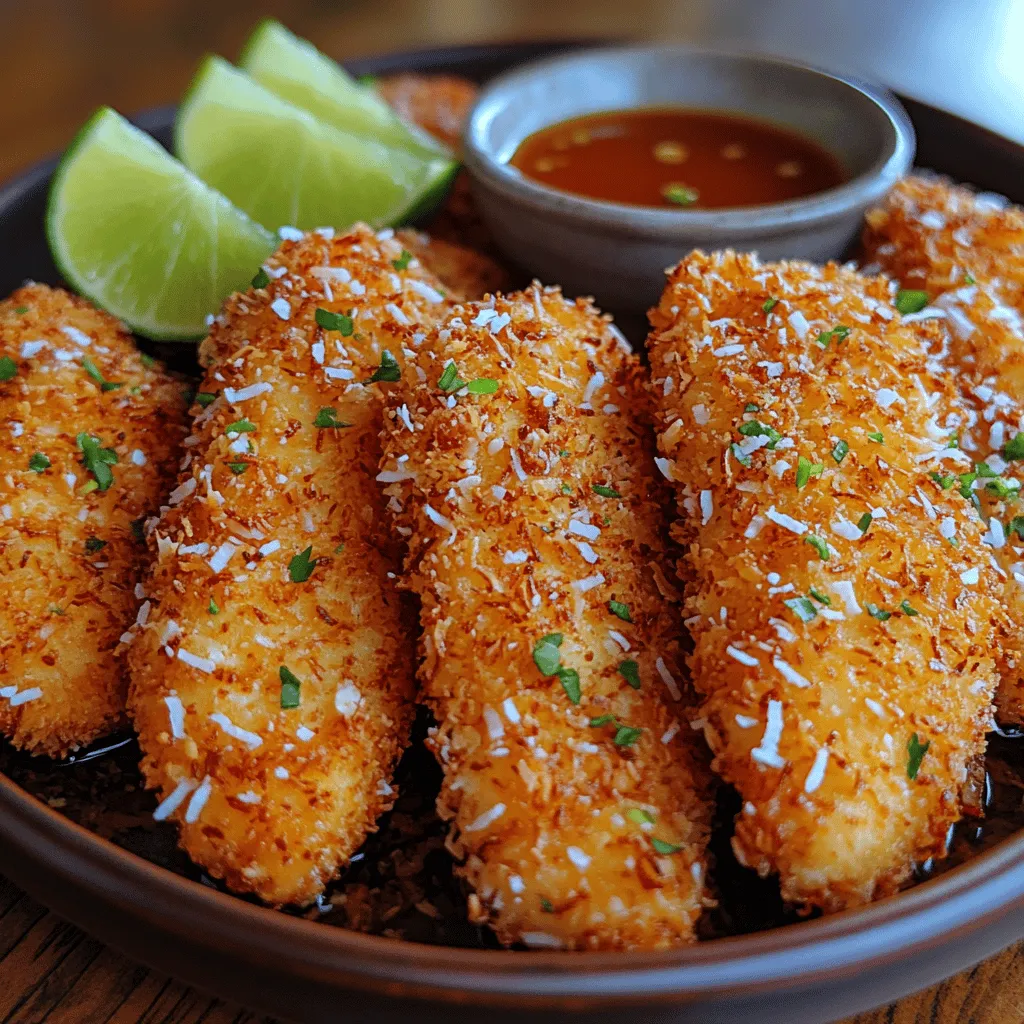Introduction
Crispy chicken strips have long been a beloved dish, appealing to both kids and adults alike with their crunchy exterior and juicy interior. This classic comfort food is often a go-to for quick weeknight dinners, casual gatherings, and parties. However, while traditional chicken strips are undeniably delicious, there’s always room for a little culinary creativity. Enter the crispy coconut chicken strips—a delightful twist that adds an exotic touch to this classic favorite. Coating the chicken with a mixture of coconut flakes and breadcrumbs not only enhances the flavor but also creates an irresistible crunch that elevates the entire dish.
These crispy coconut chicken strips are perfect for various occasions. They make an excellent centerpiece for a family dinner, a flavorful finger food for parties, or a kid-friendly option that even the pickiest eaters will enjoy. Whether you serve them with a zesty dipping sauce or alongside fresh salads, this dish promises a satisfying experience for everyone at the table.
Understanding the Ingredients
To craft the perfect crispy coconut chicken strips, it’s essential to use the right ingredients. Each component plays a significant role in achieving the ideal flavor and texture. Here’s a closer look at the key ingredients you’ll need for this recipe.
Chicken
The foundation of any great chicken strip recipe is, of course, the chicken itself. Boneless, skinless chicken breasts are the preferred choice for this dish. They are tender, easy to cut, and cook evenly, making them perfect for strips. When sliced into uniform pieces, chicken breasts not only ensure a consistent cooking time but also provide a juicy bite that balances beautifully with the crispy coating.
Flour
Flour is a crucial element in the breading process. It acts as the initial layer that helps the egg wash adhere to the chicken, ensuring that the coconut and breadcrumb mixture sticks effectively during cooking. Using all-purpose flour provides a neutral base that enhances the overall texture without overpowering the natural flavors of the chicken.
Coconut and Panko Breadcrumbs
The star of the show in this recipe is undoubtedly the coconut coating. Sweetened or unsweetened shredded coconut adds a tropical flavor that complements the chicken beautifully. For the best texture, combining coconut with panko breadcrumbs is a game-changer. Panko, which is light and crispy, contributes to an extra crunchy exterior that provides a delightful contrast to the tender chicken inside. This combination not only adds flavor but also creates a visually appealing dish that’s sure to impress.
Spices
To elevate the flavor profile of the crispy coconut chicken strips, a blend of spices is essential. Garlic powder and paprika add depth and warmth, while salt and black pepper enhance the overall seasoning. A pinch of cayenne pepper introduces a subtle kick, balancing the sweetness of the coconut and ensuring that each bite is packed with flavor. Adjusting the spice levels can easily tailor the dish to your personal preference, making it as mild or spicy as you like.
Preparation Steps for Crispy Coconut Chicken Strips
Now that we have a solid understanding of the ingredients, it’s time to dive into the preparation process. The key to achieving perfectly crispy coconut chicken strips lies in a well-organized approach to the breading and cooking methods.
Chicken Preparation
The first step in preparing your crispy coconut chicken strips is to properly cut the chicken. Start with boneless, skinless chicken breasts, trimming away any excess fat or sinew. Slice the chicken into strips, aiming for a uniform thickness of about one inch. This ensures that the chicken cooks evenly, preventing some pieces from drying out while others remain undercooked.
Setting Up a Breading Station
A well-organized breading station is essential for the success of this recipe. You’ll need three shallow dishes for the breading process:
1. Flour: Place all-purpose flour in the first dish, seasoned lightly with salt and pepper.
2. Egg Wash: In the second dish, whisk together eggs with a splash of water or milk until well combined. This will help the coating adhere to the chicken.
3. Coconut and Panko Mixture: In the third dish, combine shredded coconut and panko breadcrumbs, along with the spice blend of garlic powder, paprika, and cayenne pepper.
This setup allows for an efficient and mess-free breading process, making it easy to coat each piece of chicken thoroughly.
Breading Process
To achieve maximum adherence of the coconut and breadcrumb coating, follow these steps:
1. Dredge: Begin by taking a chicken strip and dredging it in the flour, ensuring that it is completely coated. Shake off any excess flour before moving on to the next step.
2. Dip: Next, dip the flour-coated chicken into the egg wash, allowing any excess to drip off. The egg wash acts as a glue that secures the coconut and panko mixture.
3. Coat: Finally, roll the chicken strip in the coconut and panko mixture, pressing gently to ensure that the coating sticks well. Repeat this process for all chicken strips, arranging them on a baking sheet or plate as you go.
Following these steps will ensure that each chicken strip is perfectly coated, leading to a deliciously crispy result when cooked.
As you prepare these crispy coconut chicken strips, you can already sense the exciting flavors and textures that await. Once you have your chicken breaded and ready to go, you’re just a few steps away from enjoying this delectable dish. Stay tuned for the next part of the recipe, where we’ll dive into the cooking process that transforms these beautifully coated strips into a crispy, golden-brown delight.
Importance of Temperature Control When Frying
Achieving crispy coconut chicken strips hinges significantly on temperature control during the frying process. Cooking at the right temperature ensures that the exterior becomes beautifully golden brown while the interior remains juicy and tender. If the oil is too cold, the chicken will absorb excess oil, resulting in greasy strips rather than the crispy texture you desire. Conversely, if the oil is too hot, the outside may burn before the inside is thoroughly cooked.
How to Determine the Right Oil Temperature
To determine the perfect oil temperature for frying chicken strips, a kitchen thermometer is your best friend. The ideal frying temperature ranges between 350°F to 375°F (175°C to 190°C). If you don’t have a thermometer, you can test the oil by dropping in a small piece of bread. If it sizzles and browns within about 60 seconds, your oil is ready.
Detailed Frying Instructions for Achieving Perfect Crispiness
Once your oil has reached the right temperature, it’s time to fry your coconut chicken strips. Here’s how to do it step-by-step:
1. Prepare the Chicken: Ensure your chicken strips are coated well in the coconut mixture, pressing gently to make the coating adhere.
2. Fry in Batches: Carefully lower a few chicken strips into the hot oil, ensuring they are not touching each other. Overcrowding the skillet can lower the oil temperature, leading to uneven cooking.
3. Fry Until Golden: Cook the chicken strips for about 4-5 minutes on each side or until they are golden brown. You should see a steady stream of bubbles around the chicken, indicating that the oil temperature is maintained.
4. Check for Doneness: Use a slotted spoon to remove the strips from the oil and place them on a paper towel-lined plate. This will help absorb any excess oil.
5. Rest Before Serving: Allow the chicken strips to rest for a few minutes before serving. This brief resting period helps the juices redistribute and enhances the overall flavor.
Tips on Avoiding Overcrowding the Skillet for Even Cooking
To achieve perfectly cooked coconut chicken strips, it’s crucial to avoid overcrowding the skillet. When too many strips are added at once, the oil temperature drops significantly, resulting in soggy and unevenly cooked chicken. Instead, fry in small batches. This ensures that each piece has ample space to cook evenly, leading to that desirable crunch.
Signs that the Chicken Strips Are Perfectly Cooked
Knowing when your coconut chicken strips are done is essential. Look for the following signs:
– Golden Brown Color: The exterior should be a rich golden brown, indicating that the coconut coating is crispy and well-cooked.
– Juices Run Clear: When you cut into a strip, the juices should run clear, indicating that it’s fully cooked through.
– Internal Temperature: Use a meat thermometer to check that the internal temperature has reached 165°F (74°C), ensuring the chicken is safe to eat.
Discussing the Importance of Internal Temperature for Safety
Cooking chicken to the proper internal temperature is crucial for food safety. The USDA recommends that all poultry products, including chicken strips, be cooked to an internal temperature of 165°F (74°C). This temperature ensures that harmful bacteria, such as Salmonella or Campylobacter, are effectively killed. Using a meat thermometer is the most reliable way to ensure your chicken strips are cooked safely while retaining juiciness.
Serving Suggestions for Maximum Enjoyment
Now that you have your perfect crispy coconut chicken strips, it’s time to serve them in a way that enhances their deliciousness.
Creative Serving Ideas to Elevate the Dining Experience
– On a Bed of Greens: Serve your chicken strips on a bed of mixed greens or a vibrant salad to add freshness and a pop of color to your plate.
– Taco Style: Use the chicken strips as a filling for tacos, adding shredded cabbage, mango salsa, and a drizzle of lime crema for a fun twist.
Pairing with Fresh Lime Wedges for a Zesty Kick
Adding fresh lime wedges alongside your chicken strips not only enhances their flavor but also adds a refreshing zesty kick. Squeeze some lime juice over the chicken right before serving to brighten the dish and complement the richness of the coconut.
Optional Dipping Sauces, Including Sweet Chili Sauce
Dipping sauces can take your crispy coconut chicken strips to the next level. Consider these options:
– Sweet Chili Sauce: This sauce offers a delightful balance of sweetness and spiciness, complementing the coconut’s natural flavor.
– Coconut Curry Sauce: A creamy coconut curry dipping sauce can add an exotic flair to your dish.
– Honey Mustard Sauce: The tangy-sweet combination of honey and mustard pairs beautifully with the coconut crust.
Ideas for Side Dishes to Serve Alongside Coconut Chicken Strips for a Complete Meal
To create a complete dining experience, consider serving your coconut chicken strips with these side dishes:
– Coconut Rice: The subtle flavors of coconut rice will echo the chicken’s coating, creating a cohesive meal.
– Grilled Vegetables: A colorful array of grilled vegetables adds nutrition and a burst of flavor.
– Coleslaw: A crunchy, tangy coleslaw can provide a refreshing contrast to the crispy chicken.
Nutritional Information and Dietary Considerations
Understanding the nutritional components of your crispy coconut chicken strips will help you enjoy them mindfully.
Breakdown of the Nutritional Components of the Dish
A typical serving of coconut chicken strips (approximately four strips) contains:
– Calories: 400-500 calories, depending on the cooking method and portion size.
– Protein: About 25-30 grams, providing a good source of lean protein.
– Fat: Around 20-25 grams, largely from the coconut and frying oil.
– Carbohydrates: Approximately 30 grams, primarily from the breading.
Caloric Content and Macronutrient Distribution Per Serving
This dish is relatively high in calories due to the frying process, but the protein content makes it quite filling. Balancing it with lighter sides can create a well-rounded meal.
Discussion on Potential Dietary Adjustments for Different Preferences
If you’re looking to modify this recipe to suit various dietary needs, consider the following adjustments:
– Gluten-Free Options: Substitute regular flour and breadcrumbs with gluten-free alternatives to cater to gluten-sensitive individuals.
– Baked Variation: For a healthier twist, you can bake the chicken strips instead of frying them. Spray them lightly with cooking oil and bake at 400°F (200°C) for about 20-25 minutes, turning halfway through.
Conclusion
In summary, making and enjoying crispy coconut chicken strips is a delightful culinary experience. This dish is not only easy to prepare but also offers a satisfying crunch and a burst of flavor that is sure to please any crowd. With its versatility in serving options and the ability to adapt to various dietary preferences, it’s a recipe that can easily become a staple in any kitchen.
Whether you serve them as an appetizer, a main dish, or as part of a festive gathering, these coconut chicken strips are bound to be a hit. So gather your ingredients, fire up the skillet, and treat yourself and your loved ones to this deliciously crispy delight!


